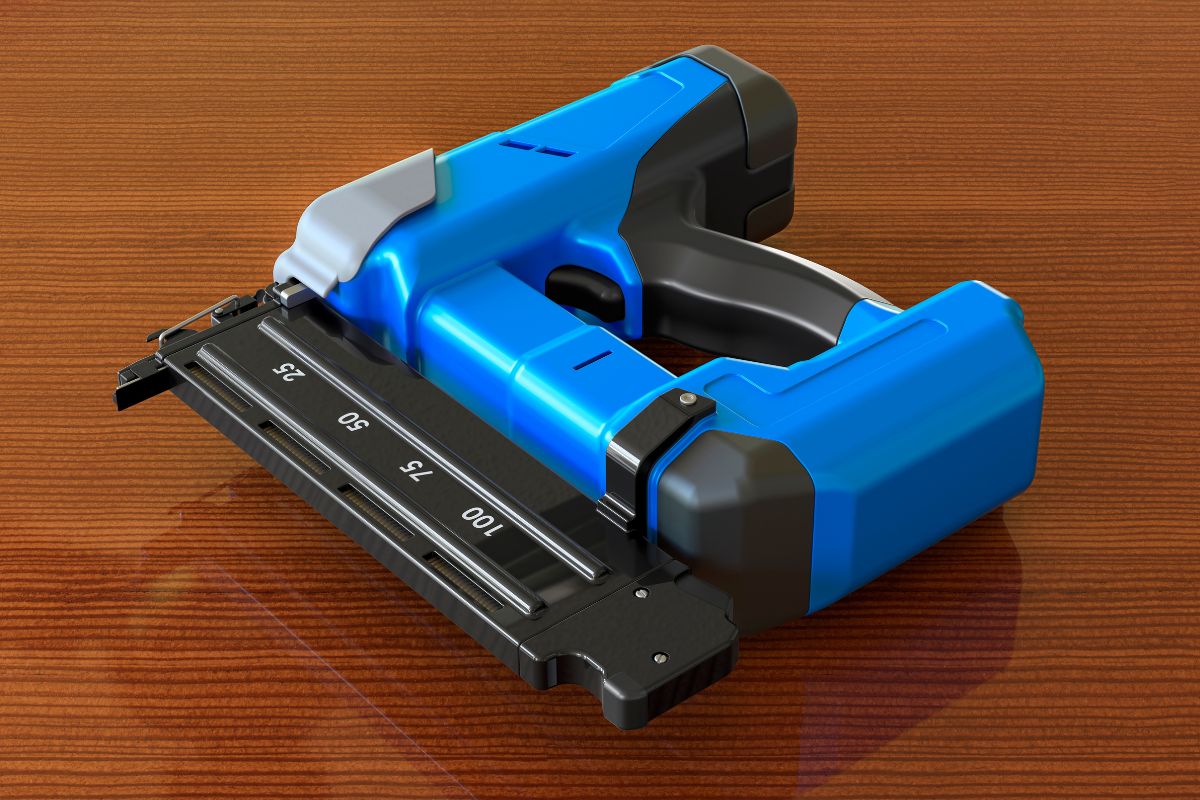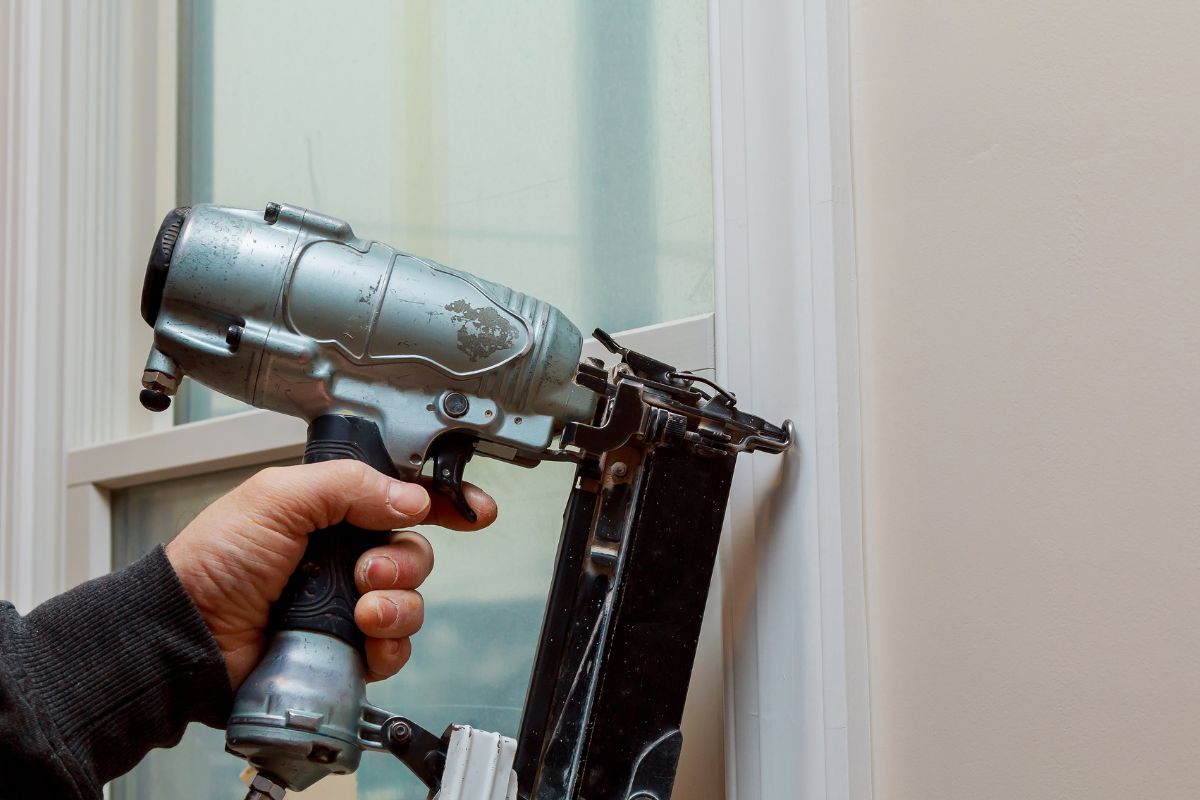your toolkit if you work a lot with thin trim and softwood. We hope this guide to a brad nailer has been helpful.

If you are doing some remodeling work or home improvements then you may have come across the name brad nailer.
What is a brad nailer, and what is it used for?
We take a look at the uses of a brad nailer and how it differs from a finishing nailer.
What Is A Brad Nailer?
A brad nailer is a nail gun that is powered either by an air compressor or by battery.
It fires 18 gauge nails which are used for attaching things like wooden moldings. This tool is used by finish carpenters and will install trim that is up to ⅜ inch thick.
The 18 gauge nails that are used in a brad nailer are 0.0475 of an inch thick. They can vary in length from ⅝ inch up to 2 ½ inch.
Although it looks very similar to a finishing nailer and is used by finishing carpenters the two are nevertheless different tools.
A brad nailer will be used on thinner softwood while a finishing nailer can penetrate plywood and thicker pieces of trim such as baseboards.
How Is A Brad Nailer Used?
The brad nailer works under compression to fire nails with force and speed into softwood up to ⅜ inch thick. To do this 18 gauge nails are loaded into a groove in the magazine of the gun which is then closed.
The brad nailer, if it is pneumatic, is then attached to the air hose of an air compressor.
To fire the nails into wood the nose of the nailer needs to be pressed firmly against the surface. This disengages the safety feature on the nailer which prevents it being fired otherwise.
Once the nose of the nailer is pressed against the wood only then should you put your finger on the trigger and apply pressure. This action will fire the nail into the wood.
Brad Nailer Vs Finishing Nailer

Brad nailers and finishing nailers are both available to buy as pneumatic or cordless tools.
They fire different sized nails into different thickness of wood. So while they may look very similar they have different applications.
Hole Size
The difference between a hole that a brad nailer will make compared to a finishing nailer is noticeable.
A finishing nailer uses 15 or 16 gauge nails which are thicker and subsequently make a bigger hole in the wood.
Typically these holes are filled with wood filler or similar and sanded down if needed.
A brad nailer fires 18 gauge nails which are thinner and so the hole that they produce is much smaller.
These holes rarely need to be filled and if they do, a minimal amount of wood filler is needed.
Nail Size
As we have mentioned a brad nailer uses 18 gauge nails while a finishing nailer uses either 15 or 16 gauge nails. But what does gauge actually refer to?
Gauge refers to the thickness or diameter of the nail therefore it is an indication of the strength of its holding power. The higher the gauge number the thinner the nail.
So, an 18 gauge nail is 0.0475 of an inch or 1.2 millimeters. A 16 gauge nail for a finishing nailer is 0.0625 of an inch or 1.6 millimeters.
Finally, a 15 gauge finishing nailer nail is 0.0720 or 1.8 millimeters.
The length of nails that you can use in a brad nailer vary from ⅝ inch to 2 ½ inch. Each size will have a separate groove in the nailer’s magazine.
You need to make sure that you are putting the correct length nail in the right groove.
Uses
One of the benefits of a brad nailer is that it can be used on quite thin softwood without splitting it. This is why it is used to attach delicate moldings or used in crafting.
A brad nailer is also very useful for working on corners as it causes less damage than bigger nailers.
A useful tip for using a brad nailer is to use it perpendicular to any narrow trim that you are attaching.
This is because if the nail moves sideways it won’t penetrate the surface of the wood, ruining your work. Instead it will just enter the wood at an angle which is not an issue.
Pneumatic Or Cordless Brad Nailer
The choice between a pneumatic brad nailer or a cordless version will depend on what you are going to use it for.
A pneumatic model will require the added bulk of an air compressor in your work space.
However, they are lighter to use as there is no battery or motor to weigh them down. Pneumatic brad nailers are also cheaper than cordless models.
Although if you don’t already have a portable air compressor you will need to buy one and this will add to your outlay.
If you don’t want to carry a portable air compressor around with you then a battery operated brad nailer will be ideal for you.
These will be more expensive than a pneumatic powered nailer but potentially more convenient.
Jobs For A Brad Nailer
So what jobs would you use a brad nailer for? Due to the small gauge of the nails this tool is perfect for delicate work such as fitting wooden trim and moldings.
It works best on thin softwood so anything that is thicker than ⅜ inch or very wide would not suit a brad nailer.
It won’t work on materials such as plywood or hardwood as the gauge of the nails is too thin and will not penetrate.
A brad nailer will work well adding a quarter round or shoe molding to baseboards. It will leave hardly any noticeable hole which nevertheless can be concealed with wood filler.
Final Thoughts
A brad nailer is a useful piece of equipment to have in
- How To Drill Into Brick? - October 31, 2022
- How To Repair And Refinish Hardwood? - October 31, 2022
- Floetrol – What Is It? When To Use It: Complete Guide - October 31, 2022
